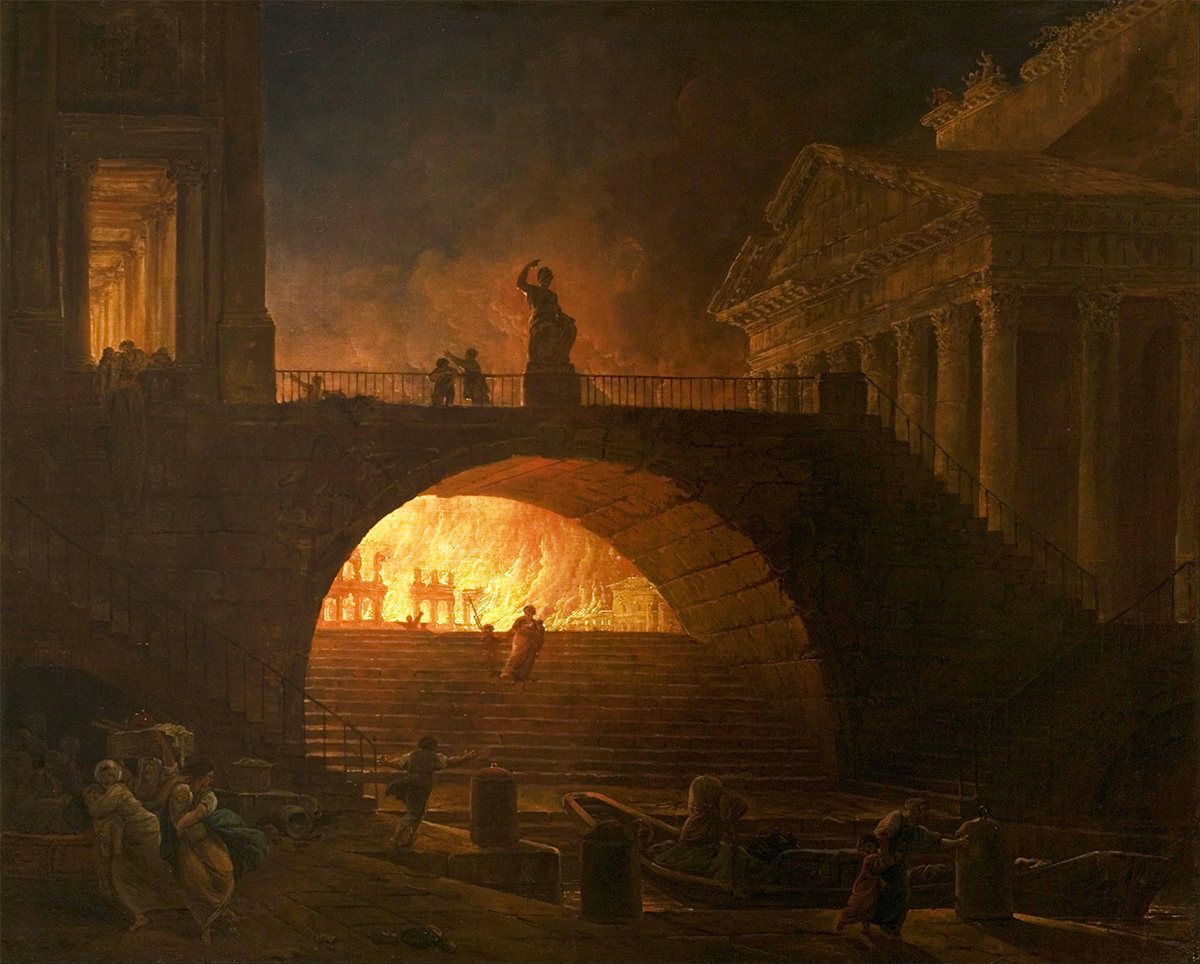
“Eo in tempore Nero Antii agens non ante in urbem regressus est quam domui eius,
quā Palatium et Maecenatis hortos continuaverat, ignis propinquaret.
Neque tamen sisti potuit quin et Palatium et domus et cuncta circum haurirentur.
Sed solacium populo exturbato ac profugo campum Martis ac monumenta Agrippae, hortos quin
etiam suos patefecit et subitaria aedificia extruxit quae multitudinem inopem acciperent ;
subvectaque utensilia ab Ostia et propinquis municipiis pretiumque frumenti minutum usque ad
ternos nummos.
Quae quamquam popularia in inritum cadebant, quia pervaserat rumor ipso tempore flagrantis urbis
inisse eum domesticam scaenam et cecinisse Troianum excidium, praesentia mala vetustis cladibus
adsimulantem 2.”
Tacitus, Annales 3
Obviously the aim of this article is not to discuss the incident nor Nero legacy to the fire but his native town Antium (modern Anzio) where he was staying at the time of the fire.
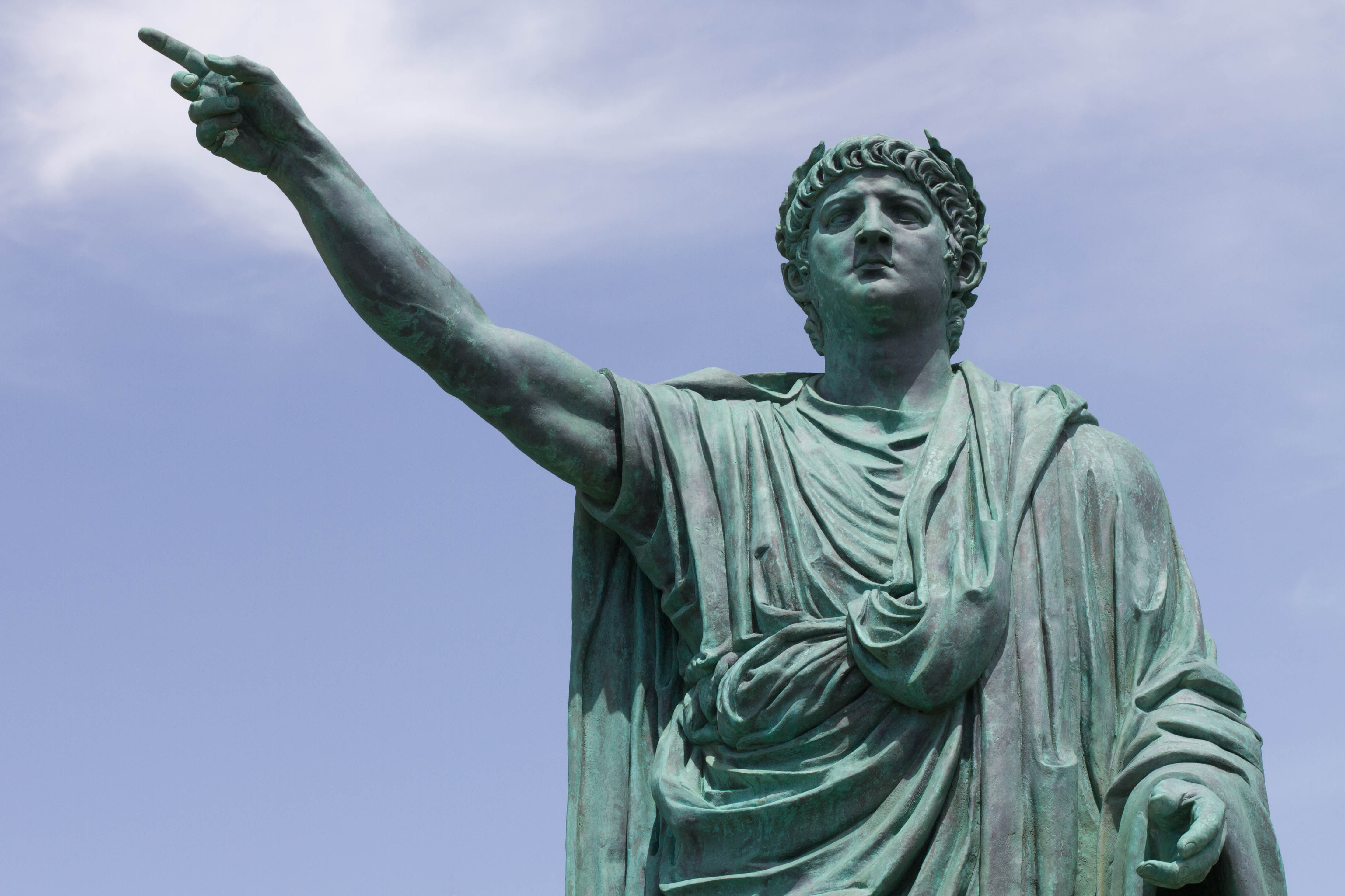
ANTIUM,
A report of Ahmed Fergiani
Various legends circulate about the origins of the city. According to the Greek historian Xenagoras4, Antium was founded by Anthias, son of Odysseus and the sorceress Circe, while another Troy myth ascribes the foundation to Ascanius, son of Aeneas and Creusa, daughter of Priam of Lavinia, daughter of Venus. This Ascanius was also called Iulus or Julus according to Virgil. The Roman family, the Gens Julia, which also included Julius Ceasar, traditionally relied on their ancestry from Julus and Venus. That is perhaps why Antium later became so popular with the Roman emperors and why they built a large palace at Antium to live a part of the year.
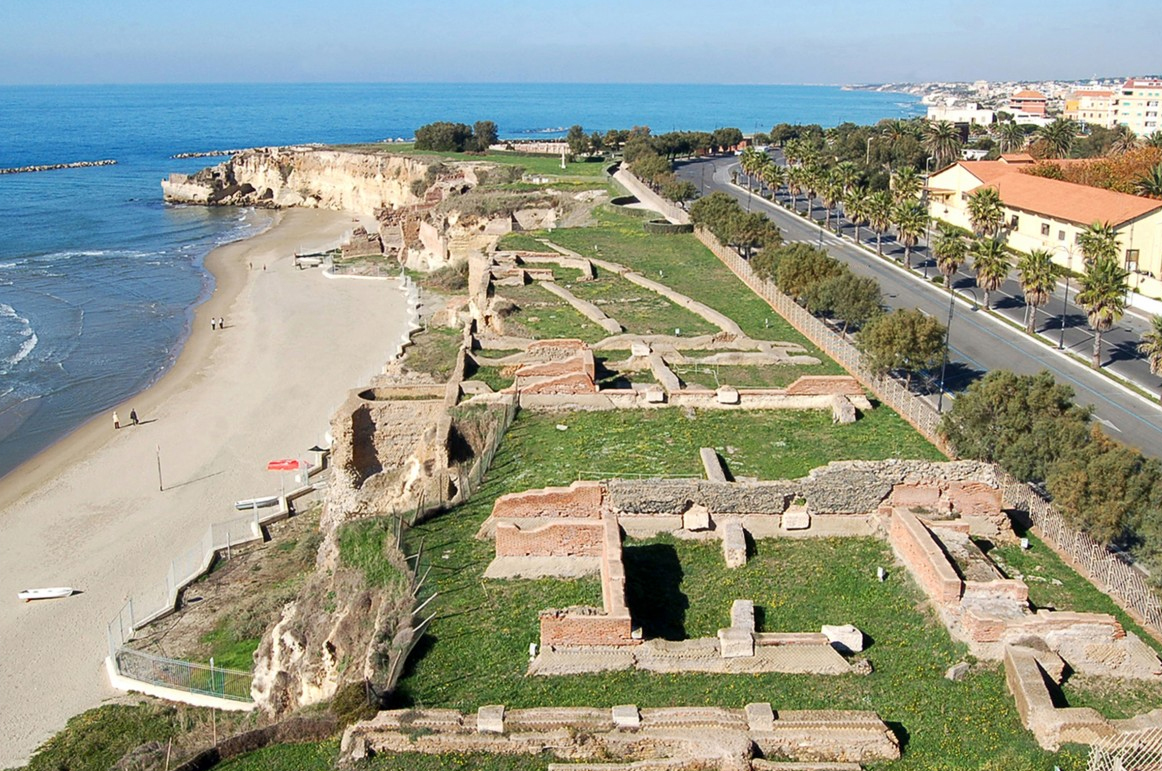
Antium, as the Latin name of the city used to be, was one of the ports in the vicinity of Rome that, like Centumcellae (Civitavecchia) 6, Ostia7 and Puteoli (Pozzuoli) 8, had to take care for commercial traffic by sea and food transports essential for the stability of Rome9.
According to Strabo10 Ἄντιον (Antium) was one of the oldest and strongest cities of Latium, situated on a promontory, 260 stages (48 kms) south of Ostia and 61 kms from Rome.
Dionysius of Harlicarnassus11 provided us with a list of the 30 cities which belonged to the "Latin League" 12 in 493 BC. on which Antium, contrary to what Strabo claimed, was not mentioned. Not long after that, the city must have fallen into the hands of the Volsci, a people who lived southeast of present-day Lazio, as Antium fought on the Volsci's side against the Latin League and the Romans. The latter conquered the city in 468 BC.
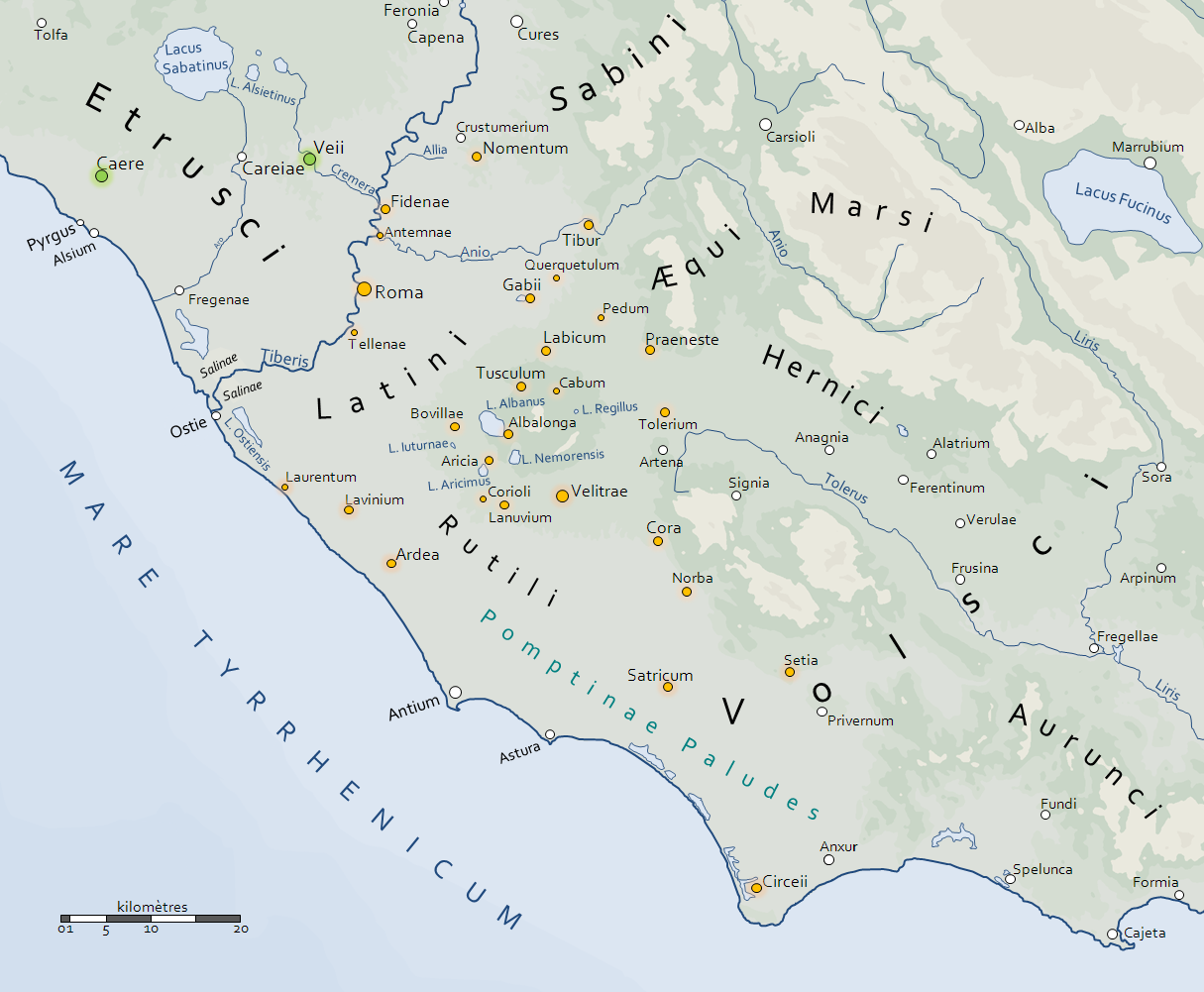
From the late republic on throughout the whole empire, Antium was the favorite country retreat for well-to-do Romans who embellished both the city and the surrounding countryside with beautiful villas such as those of the famous Cicero14, who returned after his exile and rebuilt the remains of his library, which had been partly lost, in his villa in Antium.
The most famous villa, however, was the imperial villa known as the Villa of Nero, which has been used by all emperors up to the Severian emperors. The villa ran about 800 meters along the coast.
According to the Roman historian Suetonius, Emperor Augustus was given the title of Pater Patriae (Father of the Country) 15 when he stayed in Antium in 2 BC.
Antium was also the birthplace of both Caligula and Nero who therefore gave the city special privileges. Emperor Nero in particular not only enlarged and decorated his own palace in Antium, including a theater, but also established a colony of veterans of his own bodyguard, the Praetorian Guard. He also built a "new" 16 and beautiful harbour.
Many important works of art have been found in these villas; the Girl of Anzio17 and the Borghese Galadiator18.
After the fall of the Roman Empire, Antium, like all other cities, also fell into decline. We learn from Procopius 19 that the port was in any case still functioning in 537 AD.
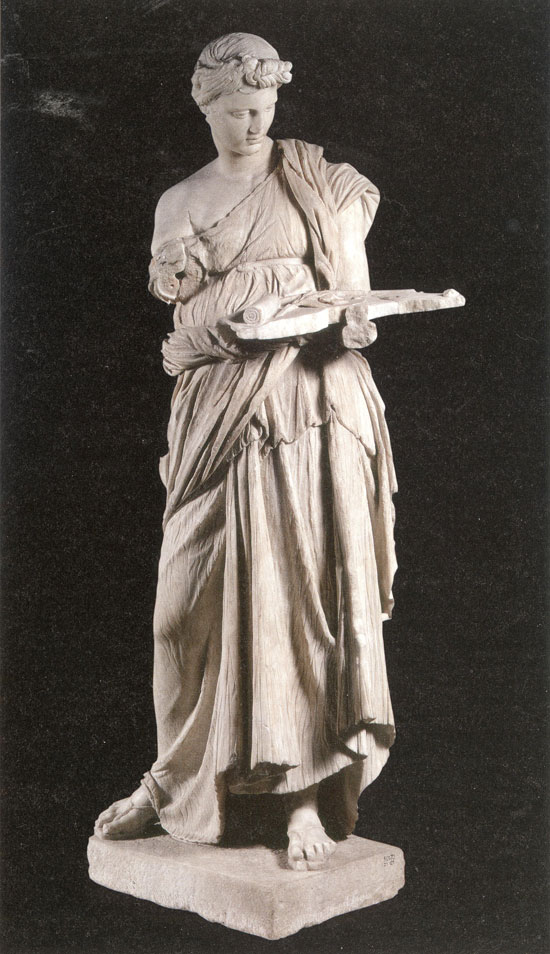
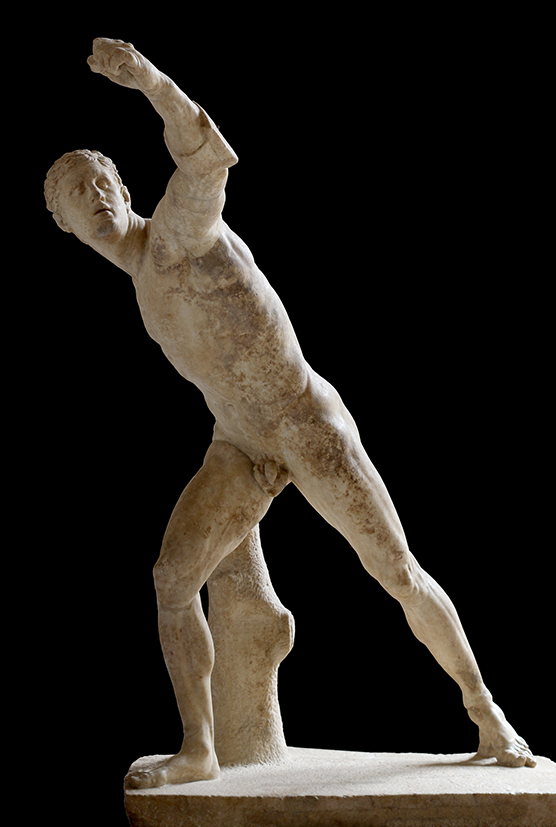
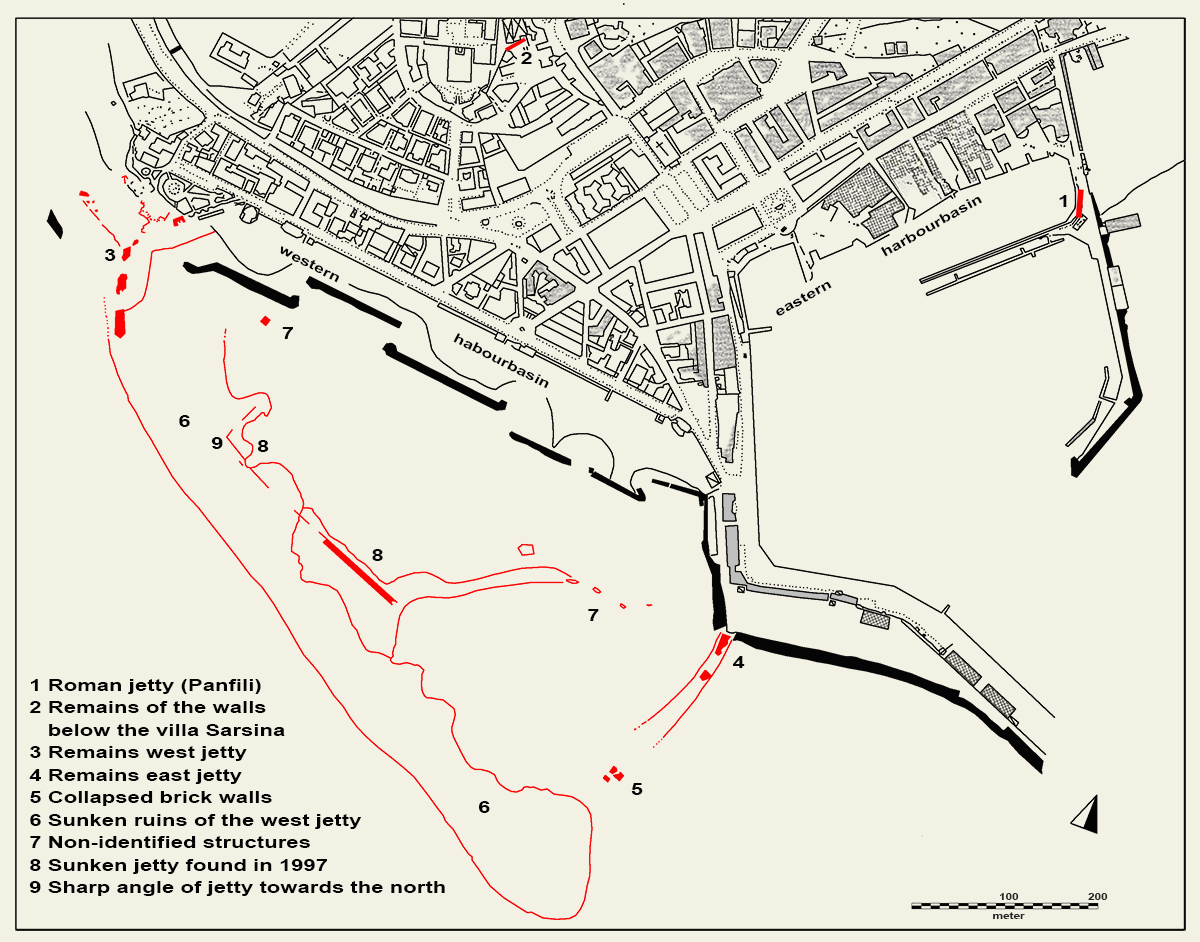
The Port
The port of Antium was an artificial harbour, which according to Suetonius Nero has built at an enormous cost, consisting of two basins with a total circumference of no less than 3.2 kms bounded by jetties built of pozzolana cement.
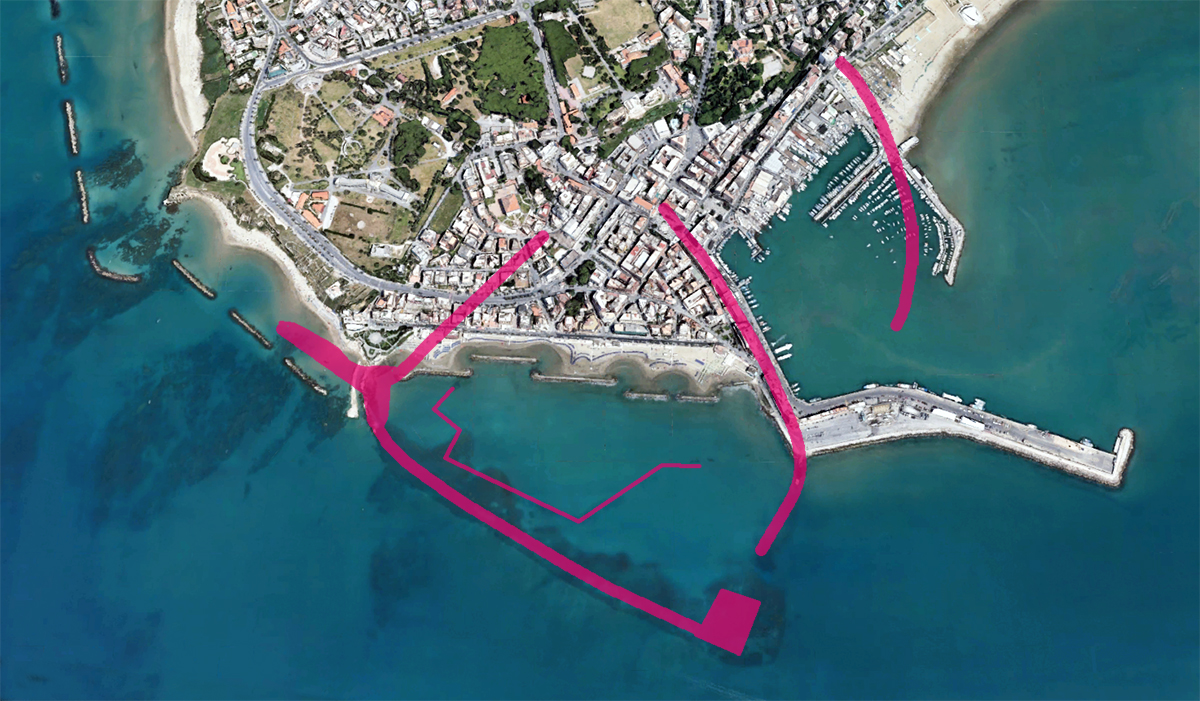
Much of the harbour is now silted up and occupied by a quarter of the modern city of Anzio.
The contours of the jetties in the still existing part of the west basin are underwater still clearly recognizable from the air and there are also various traces of cisterns, quay‘s and warehouses where Antium's most important products, such as olive oil and wine, were stored.
On the land side of the west jetty of the western basin, various parts still rise above water (see photo 8). According to many archaeologists, the jetties of Nero's harbour were, similar to the harbour of Puteoli, built from loose elements connected by arcs, allowing the sediment supplied by the current of the sea to wash away from the basin. However, new research learned us that this was definitely not the case in the port of Nero.
In addition to the western basin, the second basin has also been identified on the east side where the modern marina is now located. Here too a piece of the jetty was visible on the land side for a long time, "il Moletto Panfili" (the pleasure yacht pier). This piece of jetty was incorporated in the new pier for the marina in the early 1930s and is no longer visible.
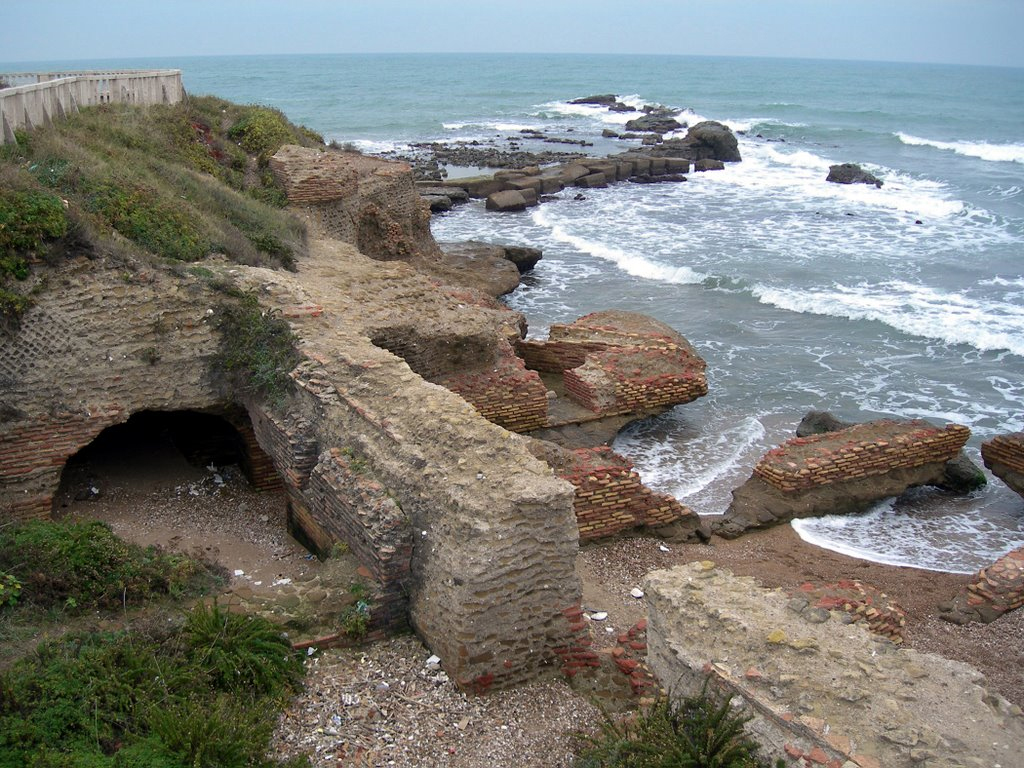
Unfortunately, it is also hardly possible to do further research on the north side of the Roman ports because a part lies hidden under the current city, such as the remains under the villa Sarsina (see photo 6-2).
A few years ago, new research has been conducted in the still existing basins of the ancient ports of Nero, in particular the western basin. Many parts of the jetties were found underwater, as well as columns and fragments of collapsed buildings that stood on those piers.
In the western basin, a long, straight section of a jetty was discovered underwater (photo 6-8) that crossed the entire basin from east to west and ran parallel to the main jetty (photo 6-6). This piece of pier with a length of 3.60 meters is made of concrete, has a maximum height of 2.50 m from the current seabed and lies at a depth of approximately 4 meters.
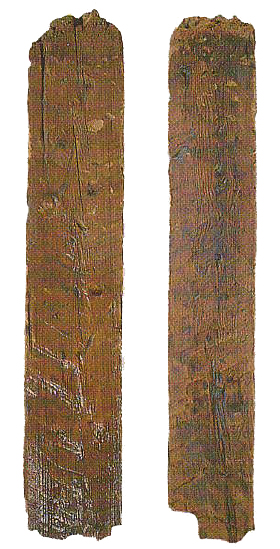
The parts of this jetty were cast underwater in a formwork 20. This formwork consisted of simple parallel sheet piles composed of vertically placed planks, 23-50 cm wide and 7-8 cm thick. The formwork was held in place from the outside by a series of posts anchored in the ground. The system was probably completed by transversely placed sealing bars held together by a hole / key system at a higher level and therefore not preserved. Too little material has been preserved to make a complete reconstruction of the formwork. On the basis of the panels still present, however, it could be notified that the pier on the westside makes a sharp turn to the north on 2/3 of the basin (see photo's 6-9 and 7).
The new jetty (photo 6-8) with a width of 3.60 m is a lot narrower than the 12 meter width of the old jetty (photo 6-6), which is conveniently called the "Nero pier". Although the construction techniques of both piers seem the same, a lesser quality cement was used for the new one, resulting in a smaller, less consistent pier. Reaearch have shown that the parts of the planks and support posts that are still present have been preserved deep in the mud of the soil.
On the eastern edge of the pier, where, despite the presence of the formwork, the concrete structure was missing, an assessment test was conducted, removing two planks for observation and documentation.
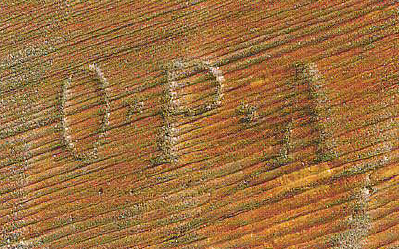
The boards were marked by origin or/and on property. Such as, for example, by using the letters OPA21. With this, "Anzio underwater" could be the largest epigraphy-on-wood-museum from ancient times.
A report from the past is known recalling that after various storm surges construction fragments were discovered that did not belong to the two jetties. These fragments can be seen on an anonymous drawing from 1819 and are mentioned as remains of "old docks". The reliability of this drawing is endorsed by aerial shots.
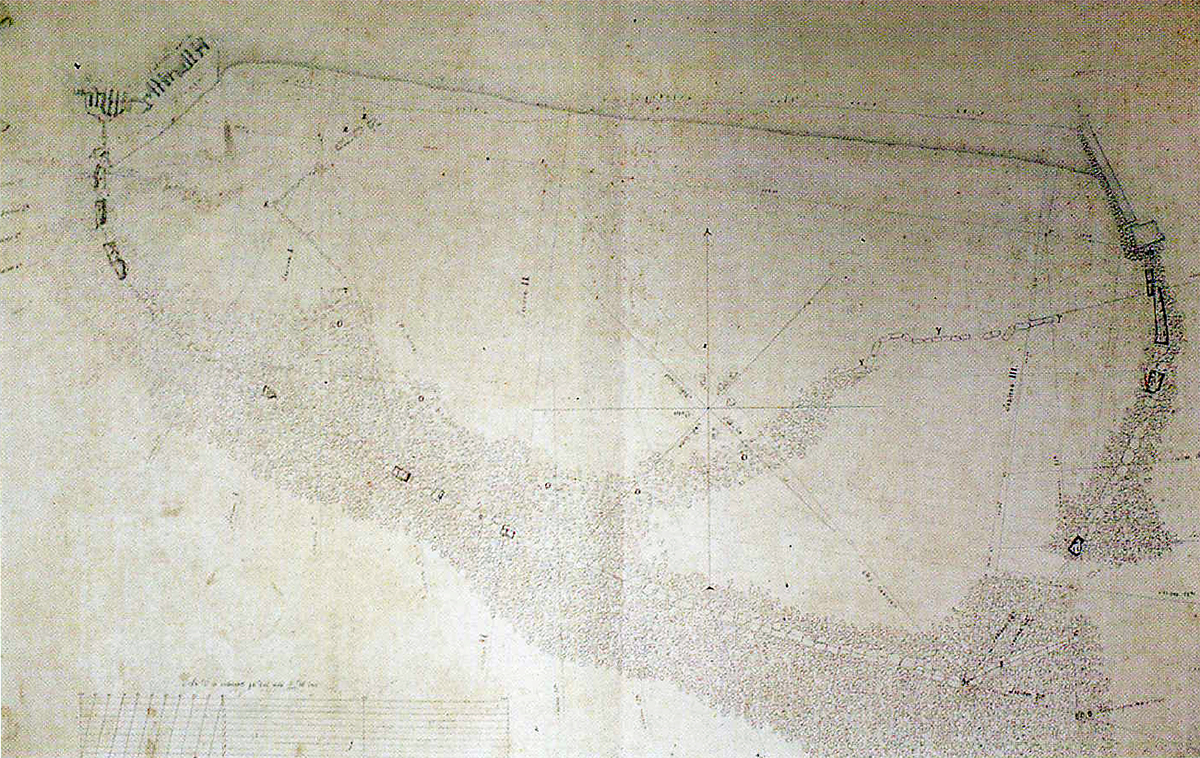
A study a few years ago showed that the construction was made using the same construction technique as the pier; it is clearly a foundation or base for a raised structure, such as a small tower or a lantern.
Conclusion
According to Enrico Felici It appears that the large western harbour basin from Nero's time was later reduced by the installation of new piers. The newly found pier structure does not belong to late antique or modern renovations: from Nero, to the construction of the new harbour by Pope Innocent XII (the end of the 17e centyry), no single source is reminiscent of maritime construction activities.
Carbon 14 research on the two wooden planks shows a date in Roman times (no later than 251 AD). In addition, there is not a single source that mentions a port before Nero's port was built. We also know the description of Strabo (V, 232): ‘Antion alimenos’ (Antium without ports). In remembering the construction of the Nero port system, Suetonius uses the verb fecit (build, make), implicitly indicating that it took place on a virgin coast. In addition, the dimensions of the new jetty are so small that, practically speaking, independently it does not provide sufficient protection in a turbulent place like the Cape of Anzio.
These arguments lead to the exclusion of a realization of the small jetty prior to the construction of "Nero's pier".
The possibility that the harbour complex is the result of several stages, such as an adjustment or improvement of the system built by Nero to fix some design flaws, cannot be excluded. The old harbour would then have undergone a radical restructuring of the original setup, using the old jetties as a shelter and obtaining a limited area inside, bounded by concrete blocks that had to be less consistent.
To me this hypothesis of Felici sounds a little bit odd. That is why we asked the opinion of the Dutch / French harbour engineer Arthur de Graauw, who is also an expert in antique harbour construction22.
De Graauw is convinced that the first jetties should be seen as breakwaters. Later, a narrower pier was built against it, which probably served as a quay with loading and unloading moorings and other port structures. The port of Caesarea in Israel also had such a double dam function.
Whatever the outcome after longer research will be, the authorities are currently recognizing the importance of this Roman port and looking at how to secure it for the future. The authorities are currently recognizing the importance of this important Roman port and looking for a way to secure Nero’s port for the future.
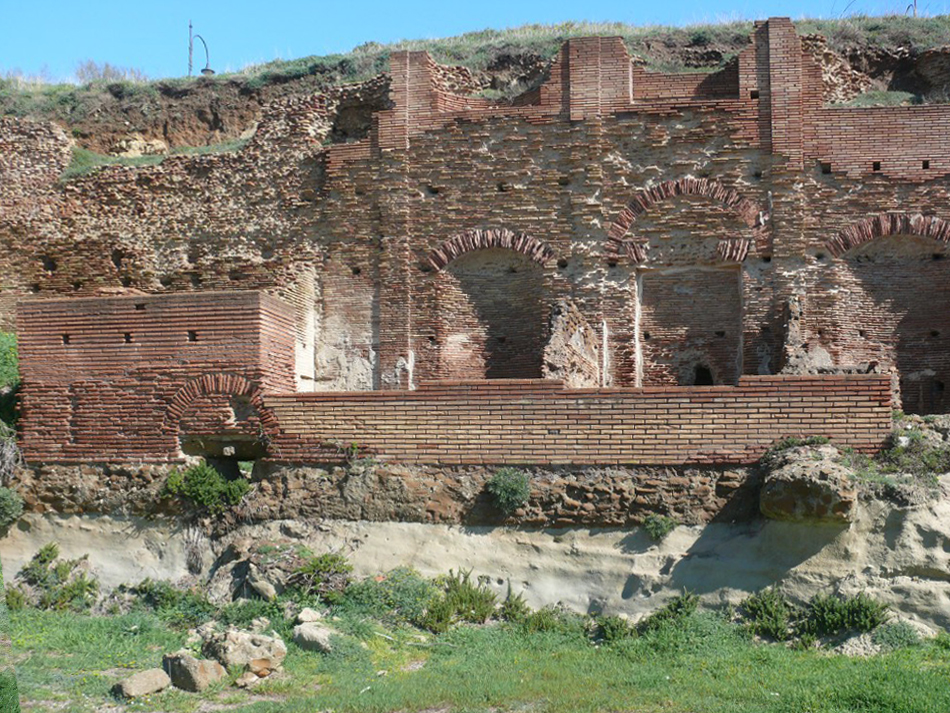
- Sources
- - Duruy, Victor, History of Rome vol. V (1883); Grant, Michael (translator), Tacitus, The Annals of Imperial Rome, (1989)
- - Fields, Farms and Colonists: Intensive Field Survey and Early ..., Volume 1 By Tymon C. A. de Haas
- -Anzio e Nerone: Tesori dal British Museum e dai Musei Capitolini by Francesco Paolo Arata, Beatrice Cacciotti, Letizia Ceccarelli, Francesco Di Mario, Alessandro M. Jaia
- -RIVISTA Del ISTITVTO D'ARCHEOLOGIA E STORIA DELL'ARTE ROMA MCMXL SAGGIO SULLA TOPOGRAFIA DELL'ANTICA ANTIUM
- - Enrico Felici: Scoperte epigrafiche e topograche sulla ,costruzione deI porto neroniano di Antium – Rome 2002
- - Anzio, archeologia subacquea e cemento Portland; L’Archeologo Subaqua 2013
- - Enrico Felici: Osservazioni sul porto neroniano di Anzio e sulla tecnica romana delle costruzioni portuali in calcestruzzo; Rome 1993
- - Arthur de Graauw - www.AncientPortsAntiques.com
- Notes
- 1:Oilpainting on canvas by Hubert Robert (1733 – 1808. Musee de Buaux-Aerts, Le Havre, France
- 2: Annals of Tacitus XV-39. Vertaling: Nero at this time was at Antium, and did not return to Rome until the fire approached his house, which he had built to connect the palace with the gardens of Mæcenas. It could not, however, be stopped from devouring the palace, the house, and everything around it. However, to relieve the people, driven out homeless as they were, he threw open to them the Campus Martius and the public buildings of Agrippa, and even his own gardens, and raised temporary structures to receive the destitute multitude. Supplies of food were brought up from Ostia and the neighbouring towns, and the price of corn was reduced to three sesterces a peck. These acts, though popular, produced no effect, since a rumour had gone forth everywhere that, at the very time when the city was in flames, the emperor appeared on a private stage and sang of the destruction of Troy, comparing present misfortunes with the calamities of antiquity.
- 3: Publius Cornelius Tacitus (ca. 56-117), Roman consul, historian, writer and orator
- 4: Mentioned by Dionysius van Halicarnassus , a Grieek-speaking Roman writer from the 1e century BC who lived from 60 BC till 7 AD
- 5:Photo Wikipedia – Hellen Cook
- 6:see Centumcellae
- 7: seeOstia
- 8: seePuteoli
- 9:see Panem et Circumstances
- 10: Strabo v.p. 232
- 11:Greek writing Roman writer who lived from 60 BC till 7 AD.
- 12:Latin Liga (7th century BC. – 338 BC) was a confederation of approximately 30 villages and tribes in the province of Latium, with the aim of joint defense. In the mentioned year 493 BC. the League forms an alliance with Rome.
- 13: Wikimedia - Cassius Ahenobarbus
- 14: Marcus Tullius Cicero was a Roman orator, politician, lawyer and philosopher. (106 - 43 BC) He writes his friend Atticus on June 56 BC. from Antium: Att.IV.4a.1: „Perbelle feceris si ad nos veneris. Offendes designationem Tyrannionis mirificam librorum meorum . . . Et velim mihi mittas de tuis librariolis duos aliquos, quibus Tyrannio utatur glutinatoribus, ad cetera administris, iisque imperes ut sumant membranulam ex qua indices fiant, quos vos Graeci, ut opinor, σιττàâας appellatis”. Vertaling: "You should definitely come and have a look! You will find a fine catalog, made by Tyrannio, of my books, the surplus of which looks much better than I thought. Please send me two men from your staff, then Tyrannio can put them on and other work, and have them bring a piece of parchment to make labels of it, which you, Greeks (Atticus, although Roman, preferred to stay in Greece), call “sittybai”, I think ”
- 15: Roman honorary title awarded exceptionally by the Senate to people who had made a special contribution to the Roman State.
- 16: Perhaps Antium had an open anchorage for the construction of Nero's harbor or used the old harbor of the adjacent Nettuno (Caeno).
- 17: Statue found in a niche in the Villa Imperiale in Anzio in 1878. Current location Museo Massimo in Rome
- 18:Statue found before 1611 in Nero's palace in Anzio. Image is of a warrior and not a gladiator. Current location The Louvre Paris.
- 19: Procopius of Caesarea Byzantine historian (6th century AD)
- 20: For underwater concrete zie ook https://www.romanports.org/en/articles/ports-in-focus/542-a-jewish-port-for-the-emperor.html en https://www.romanports.org/en/articles/ports-in-focus/527-alexandria-the-largest-port-of-all.html
- 21: O(pus) P(ortus) A(ntiatum) vel A(ugusti) vertaald: Work on the port of Antium or of the emperor
- 22: zie https://www.ancientportsantiques.com/






 We are committed to providing versions of our articles and interviews in several languages, but our first language is English.
We are committed to providing versions of our articles and interviews in several languages, but our first language is English.